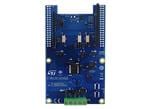
It is the PCB part, looking in figure, that is close to the two small buttons and that can easily be physically split this helps reducing the NUCLEO board size that actually runs the applications. There is more CN7 and CN10 Morpho connectors are replicated also on the board backside (always with male contacts strips), allowing you to mount the NUCLEO board on another board that could be seen as a new shield and that can access (also and not only) to Arduino pinout.Īnother interesting feature is the presence on the NUCLEO board of a PCB area that is always part of the board, but serves exclusively to its programming and debugging. This allows the card to be used in other projects which require greater connectivity.
#Nucleo f401re clion software#
This helps us to debug software easily and to use those outputs when some shields don’t pass-through.ĬN7 and CN10 connectors pins are not connected to Arduino compatible connector and they provide other proprietary I/O or power connector typical of STM32 microcontrollers. In figure Arduino pinout is shown in purple, while the Morpho pinout is in blue: notice how all Arduino pins are remapped exactly on Morpho inner pin strip (connectors CN7 and CN10): this allows us to always have access to Arduino pinout also once a shield is plugged on the board. Externally, however, two double strips of male contacts (one per side) are what STM calls “Morpho” pinout, used on other STM development boards. One of the first aspects that we can note is the presence of many contacts on card’s border, including the now famous female contacts connector compatible with the Arduino shield. Each NUCLEO board differs for performances, power consumption, clock frequency and flash memory capacity of the STM32 microcontroller in figure.Īll the boards, however, have the same layout and the same form, which is shown in next figure.įrom here on, we will analyze the NUCLEO model F401 and we will move our first programming steps, but many of the aspects and features that we will see later will be valid for any other NUCLEO board.

#Nucleo f401re clion series#
The whole series of NUCLEO development boards is equipped with a STM32 microcontroller based on ARM Cortex-M family, adopting a 32-bit RISC architecture. The board name comes from the microcontroller mounted on the board ( STM32F401) which is its heart.
#Nucleo f401re clion how to#
We will also see how to program it and test it by using some development environments available and a first sample program.

In this post we will examine the NUCLEO F401RE board that is among the best performing in the series, not only because it is based on an ARM processor with a 84 MHz clock, a 512 Kb flash memory and an integrated floating-point unit, but also for a number of interesting features that we will see together.


Some of these boards are simple clones, other are at much higher level having better performances and memory storage.Īmong those, a really interesting solution is represented by the development boards family called NUCLEO made by STMicroelectronics, a semiconductors leader company. The success of Arduino and its countless shields, kicked off in recent years the birth of several compatible development boards designed to help us creating in a short time, at low cost and easily, great and even complex electronic applications. Today we present the first steps with the NUCLEO development boards, produced by STMicroelectronics, that can help us to move towards the ARM 32-bit world with simplicity and great performances, keeping a compatibility with Arduino expansion connectors so that we can use its commonly available shields.


 0 kommentar(er)
0 kommentar(er)
